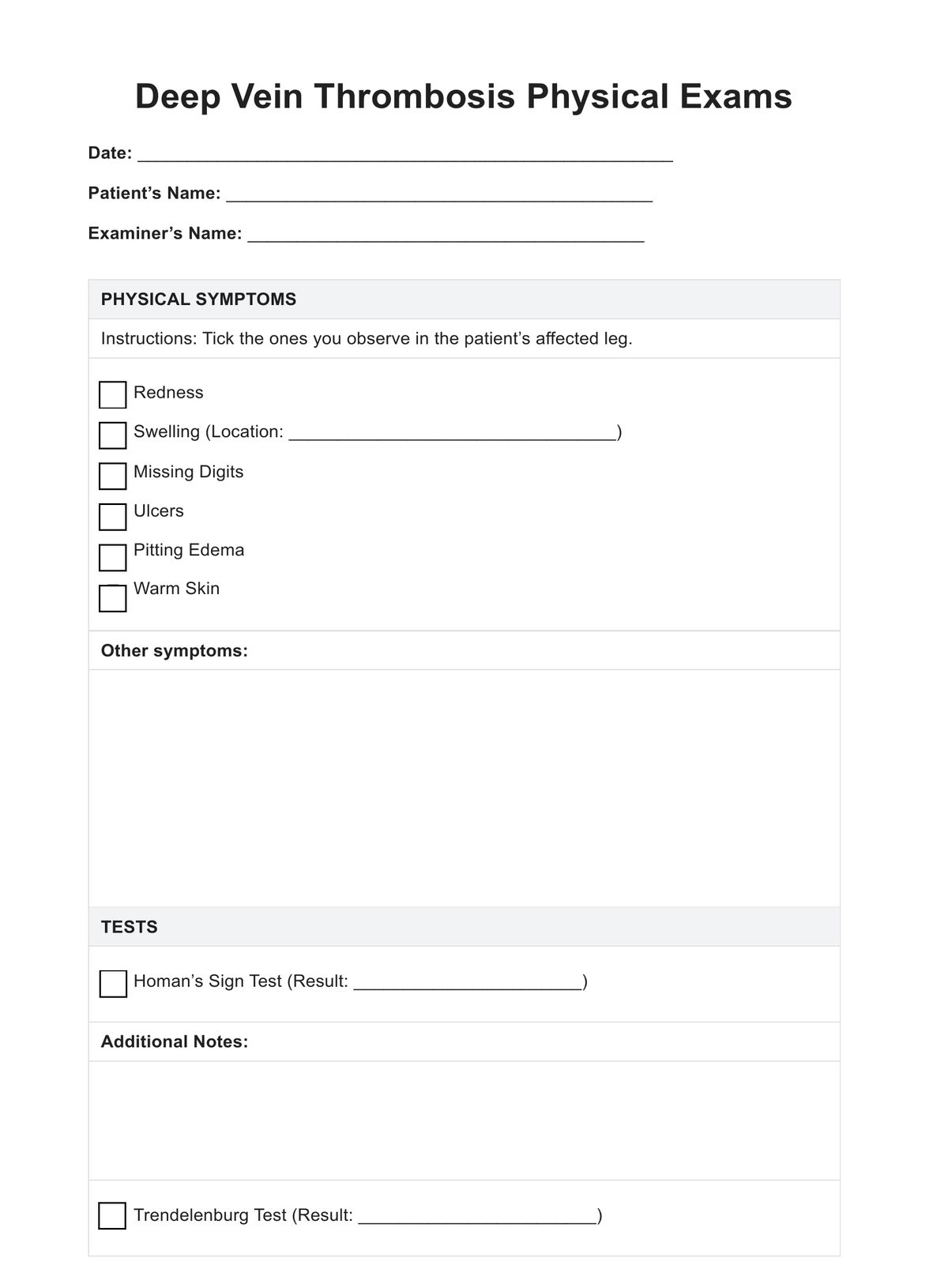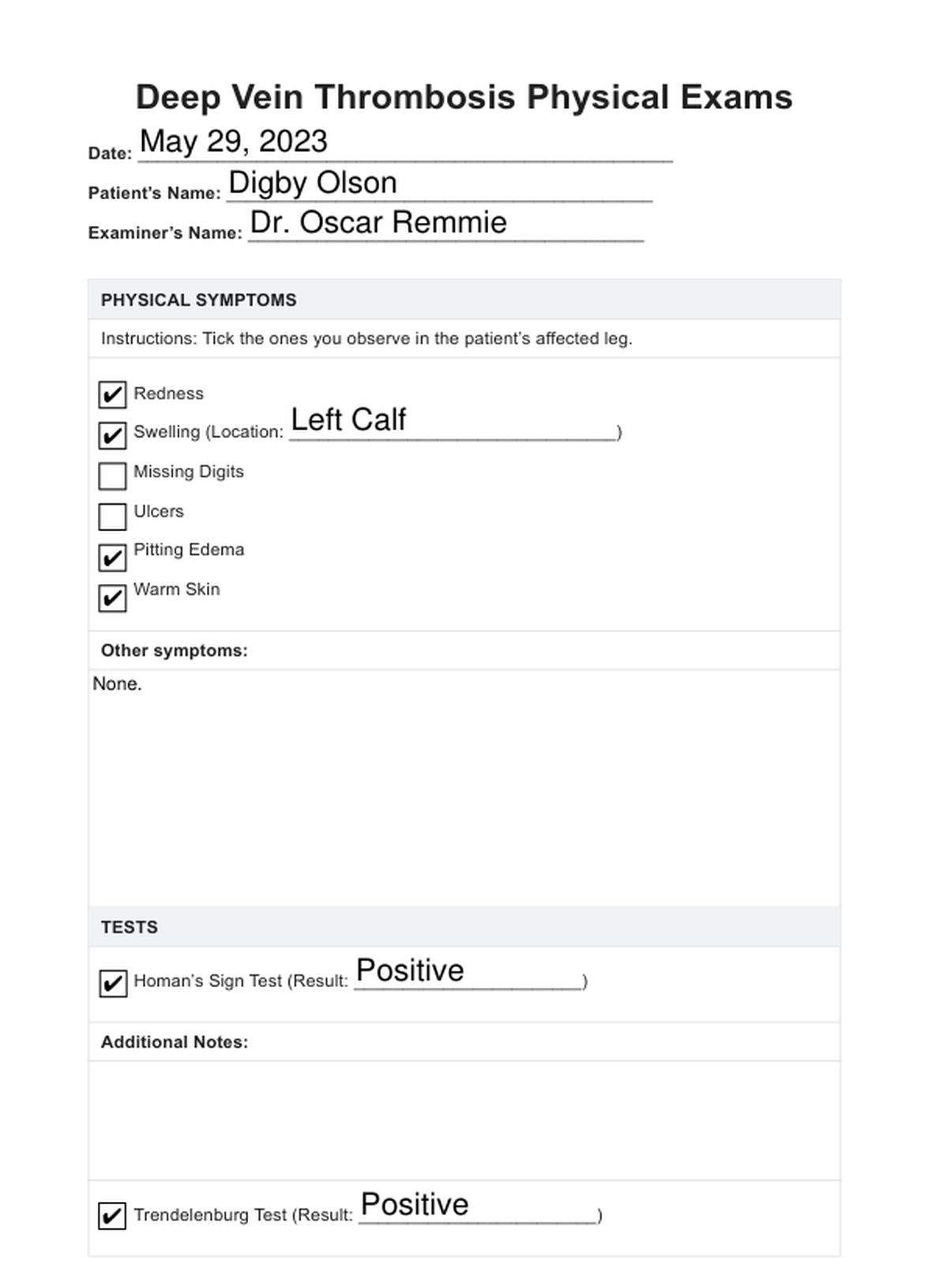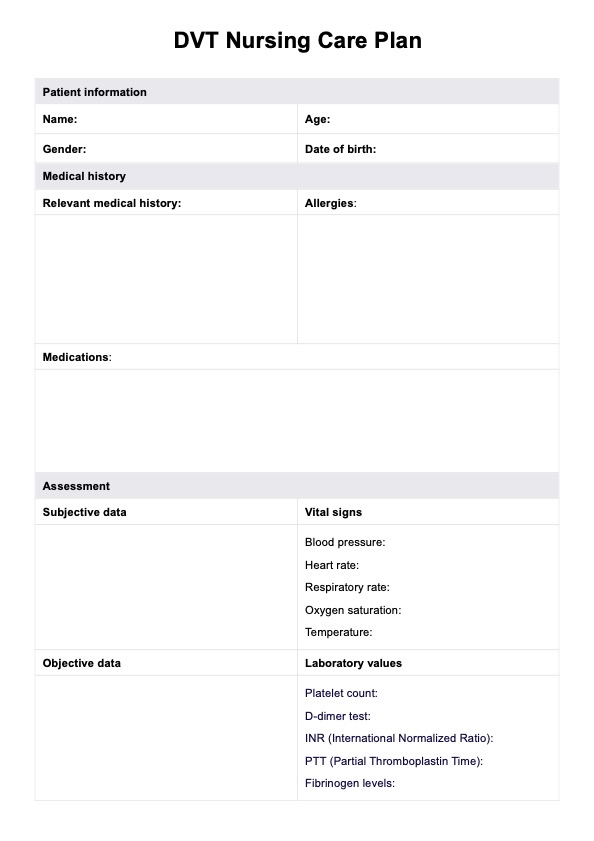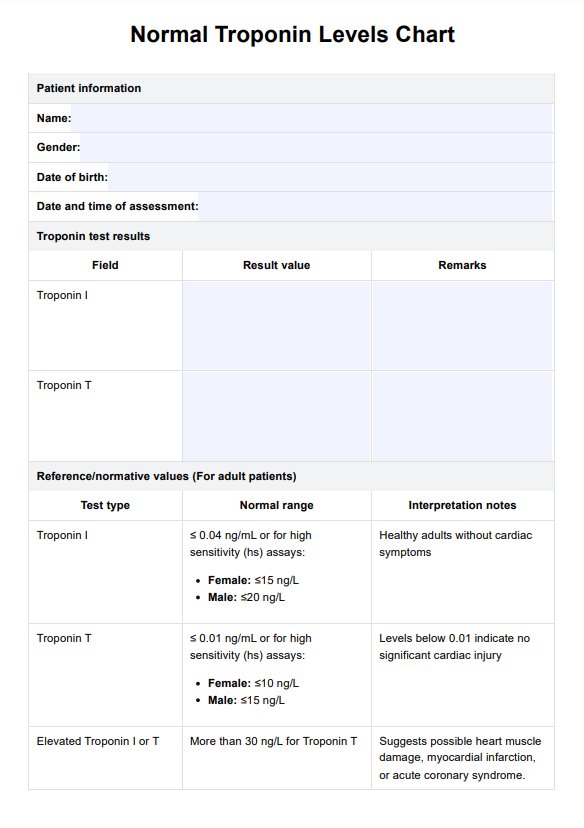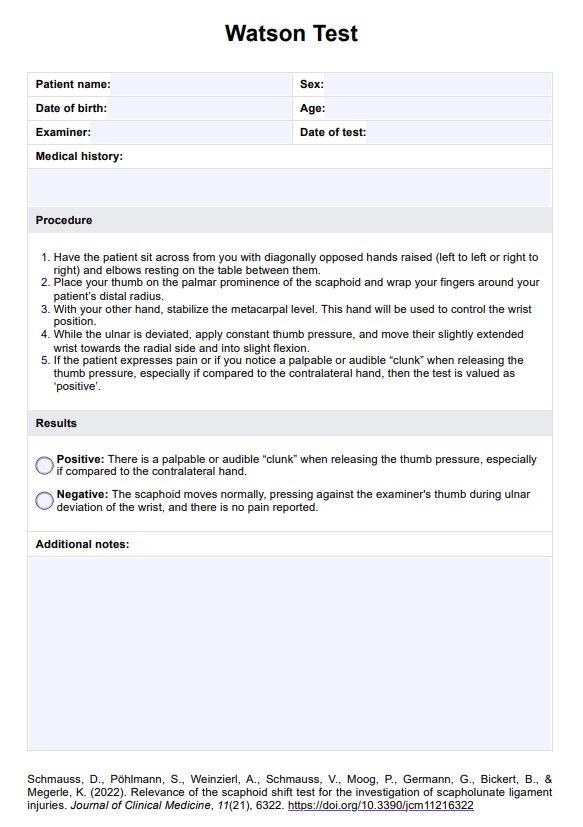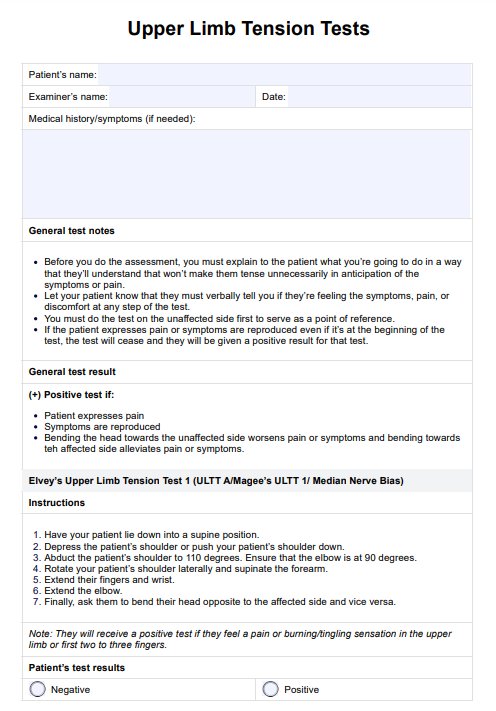DVT Physical Exam
Here’s a compilation of DVT physical exams you can conduct on your patient to assess if they have deep vein thrombosis. Click here for a guide and a copy of our free template.


What is a DVT Physical Exam?
DVT Physical Exam is done by practitioners to assess if the patient’s exhibited symptoms are caused by deep vein thrombosis. These physical exams and other assessments, such as the D-dimer test, ultrasound scan, and venogram, are needed before diagnosing deep vein thrombosis.
It’s important to note that only one of these tests, the Homan’s sign test, is explicitly used to determine if a patient has DVT, while the others are used to check if the patient has the symptoms of deep vein thrombosis.
Deep Vein Thrombosis Symptoms
Deep vein thrombosis is when a blood clot forms in one or more of the deep veins in the body. This is commonly in the legs. It is important to identify DVTs to prevent pulmonary embolisms, which can be life threatening. Symptoms include the following:
- Oedema
- Pain
- Peripheral venous distinction
- Erythema and warmth
- Unilateral leg or arm swelling
- Shortness of breath
Here’s a list of the DVT physical exams we’re referring to in this guide:
- Homan’s Sign test
- Trendelenberg Test
- Lowenberg Sign/Test
- Schwartz’s Test
- Perthes’ Test
If you’re a practitioner in charge of diagnosing DVT and think you’d benefit from having a template that compiles all of these tests and can serve as a guide, reference, and document to write down your patient’s results, we’ve got some good news for you. We’ve created a template just for you.
In our template, you can expect to find the following:
- Essential information like the examination date, patient’s name, and your name
- A list of physical symptoms you can check
- A list of all of the DVT physical exams mentioned above
- A dedicated space for your patient’s results and additional notes or findings
Check out this video to learn more about DVT Physical Exams:
DVT Physical Exam Template
DVT Physical Exam Example
How Does it Work?
Step One. Download the Template
Access and download our Printable DVT Physical Exam template by doing either of the following:
- Clicking the “Use this Template” or “Download Template” button above
- Searching for the “DVT Physical Exams” in Carepatron’s template library on our website or app
And just in case you need Trendelenburg Test, you can click here or search for the “Trendelenburg Test” in the template library.
Step Two. Conduct the Tests
Before conducting the tests, complete the required basic information: examination date, patient’s name, and your name. Afterward, you can proceed with testing.
We will leave it up to you and your expertise to decide which test to conduct and the testing order.
Step Three. Interpret and Record the Results
After you finish every test, you are encouraged to interpret the results - whether their reaction signifies a positive or negative test - and record it on the template. Feel free to include additional symptoms they present that are indicative of DVT and write down additional notes per physical exam.
Step Four. Proceed with Further Testing
As mentioned in the first section, practitioners diagnose DVT with physical exams alone. Hence, if the patient has the symptoms or tests positive in at least one of the physical tests, it’s best to have them undergo further testing.
When Would You Use this Template?
Practitioners can use the DVT Physical Exam Template when the patient exhibits symptoms of DVT, or they have the risk factors of developing it.
For a list of the symptoms and risk factors, look below.
Symptoms:
- An ache, pain, swelling, or tenderness in the affected leg’s calf or thigh, more specifically, the affected area
- Warm and red-colored skin around the area
- Red skin on the back of the patient’s leg, most of the time below the knee
- Stiff or sore swollen veins
Risk Factors:
- Those who are over 40 years of age, pregnant, or overweight/obese
- Those who are pregnant
- Those who have a history of DVT, blood clots, pulmonary embolism
- Those taking medications or have conditions that’ll make their blood clot easily, like blood vessel damage, cancer, thrombophilia, heart and lung disease, etc.
- Those who have been inactive for an extended period of time
Benefits
Easy to Understand
Since our Free DVT Physical Exams template is simple and straightforward, it’s easy to understand and even easier to fill out when you need to record results after conducting the tests.
Comprehensive
Even though there’s no standardized template, we’ve decided to make ours as comprehensive as possible by including a space where you can record the symptoms and physical tests that may help practitioners diagnose DVT or better see the symptoms.
Written Results for Future Reference
The benefit of having a template that compiles several DVT physical exams and lists the disease’s symptoms is that you don’t have to worry about forgetting the results or constantly being asked by practitioners caring for the same patient.
Accessible
With our digital template, you and your fellow practitioners can easily find and download it across devices. Furthermore, if you save the document on Carepatron, you can limit viewing access to relevant parties only.
Research and Evidence
Little research or evidence proves that the physical exams mentioned above can be used to diagnose deep vein thrombosis. However, some studies state that specific physical assessments like the Homan’s sign and checking symptoms, in particular, are still helpful assessments a practitioner can use to diagnose DVT if they follow them up with additional tests. The studies that state them are as follows:
- According to Oudega, Moons, and Hoes (2005), patient history and physical examination can only do so much to check a patient's DVT probability. The two assessments must be followed up with “further diagnostic work-up.”
- According to Ambest, Obiagwu, and Shetty (2017), the Homa’s sign and a clinical exam can only be of value if accompanied by other tests such as ultrasonography and venography. However, practitioners still utilize Homan’s test “because of its easy technique and simple demonstrability.”
References
Ambesh, P., Obiagwu, C., & Shetty, V. (2017). Homan's sign for deep vein thrombosis: A grain of salt?. Indian heart journal, 69(3), 418–419. https://doi.org/10.1016/j.ihj.2017.01.013
Ruud Oudega and others, Limited value of patient history and physical examination in diagnosing deep vein thrombosis in primary care, Family Practice, Volume 22, Issue 1, February 2005, Pages 86–91, https://doi.org/10.1093/fampra/cmh718
Commonly asked questions
Several practitioners, like primary care providers, hematologists, and vascular medical specialists, can use DVT physical exams.
You use these exams when your patient is experiencing DVT symptoms in their legs or is at risk of developing the disease. For a comprehensive list of both, please refer to the “When Would You Use this Template?” section above.
You store the DVT physical exams by printing them out and placing them in a secure drawer alongside the patient’s other medical records. Alternatively, you can store them online on a HIPAA-compliant, secure EHR platform like Carepatron.


